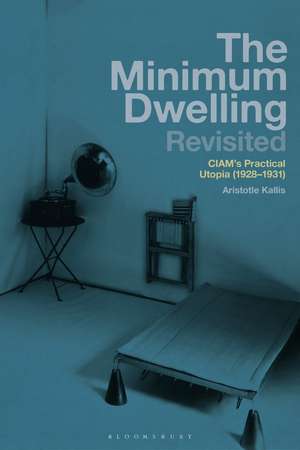The Minimum Dwelling Revisited: CIAM's Practical Utopia (1928–31)
Autor Professor Aristotle Kallisen Limba Engleză Hardback – noi 2023
Preț: 512.78 lei
Preț vechi: 732.60 lei
-30% Nou
Puncte Express: 769
Preț estimativ în valută:
98.13€ • 101.38$ • 81.63£
98.13€ • 101.38$ • 81.63£
Carte disponibilă
Livrare economică 26 februarie-12 martie
Livrare express 11-15 februarie pentru 122.25 lei
Preluare comenzi: 021 569.72.76
Specificații
ISBN-13: 9781350346185
ISBN-10: 1350346187
Pagini: 248
Ilustrații: 36 bw illus
Dimensiuni: 156 x 234 x 21 mm
Greutate: 0.64 kg
Editura: Bloomsbury Publishing
Colecția Bloomsbury Visual Arts
Locul publicării:London, United Kingdom
ISBN-10: 1350346187
Pagini: 248
Ilustrații: 36 bw illus
Dimensiuni: 156 x 234 x 21 mm
Greutate: 0.64 kg
Editura: Bloomsbury Publishing
Colecția Bloomsbury Visual Arts
Locul publicării:London, United Kingdom
Caracteristici
Draws extensively on a wide range of archival material, shifting focus to the often-overlooked 2nd and 3rd CIAM conferences and the lead up to them
Notă biografică
Aristotle Kallis is Professor of Modern and Contemporary History at the School of Humanities, Keele University, UK.
Cuprins
List of IllustrationsAcknowledgmentsAbbreviationsIntroduction'Contact Zone' and 'Practical Utopia'Structure1. Genealogies of the MinimumPoverty, 'Human Needs', and 'Minimum'Habitation and 'Minimum Needs'Early Interventions and Reform InitiativesExistenzminimumThe Low-cost Housing Calculus2. The 'Small Dwelling' Between Emergency and AspirationSize and DwellingThe 'Small Dwelling' after WW1From the 'Small' to the 'Smallest' Dwelling (Kleinstwohnung)The Pioneering Cases of Vienna and Frankfurt3. International Expert Networks and The Housing Question in the Interwar PeriodThe IFHTP Encounters the Question of Mass Housing: Vienna, 1926The IFHTP Congress in Paris, 1928: The Trope of the 'Housing For the Very Poor'The IFHTP Congress in Rome, 1929: Planning and Financing Mass Urban Housing4. The 'Minimum Dwelling' as UtopiaWW1 as Rupture: The Space of UtopiaInterwar Modernism as Discourse: Minimum and OptimumArchitecture as RevolutionThe Private Cell, The Public Sphere, and What Lies In-BetweenThe Soviet Experience: Pursuing the Minimum in UtopiaThe 'Dwelling Ration': Social Utopia in Disguise'Frictionless Living': The Studies of Alexander Klein5. CIAM2: The 'Minimum Dwelling' In FocusCIAM and its 'Lesser' CongressesCIAM's First Steps and the Question of DwellingSetting Up the First 'Working Congress'The 1929 Frankfurt Congress (CIAM2)Language Matters: The Opacity of the ExistenzminimumThe Aftermath of the Frankfurt Congress6. CIAM3: Dwelling as the Unlikely Hub og Modern ArchitectureFrom CIAM2 to CIAM3: Exploring Scales in Three-Dimensional SpaceThe Elusive Theme(s) of CIAM3: The Battle of the ScalesThe Brussels CongressThe 'Minimum Dwelling' in CIAM37. The CIAM2 and CIAM3 ExhibitionsThe Exhibition Field in Interwar Europe: Showcasing the 'Minimum'The Minimum Dwelling on Show: Exhibiting CIAM2Exhibiting CIAM3ConclusionsBibliographyIndex
Recenzii
The early Modern Movement was passionately committed to addressing the housing needs of the industrial working classes. In this meticulously researched book, Aristotle Kallis presents an authoritative account of the emergence and significance of the Minimum Dwelling (Existenzminimum) as an important expression of that commitment. It supplies important new understandings to our knowledge of twentieth-century European architectural and planning history.
